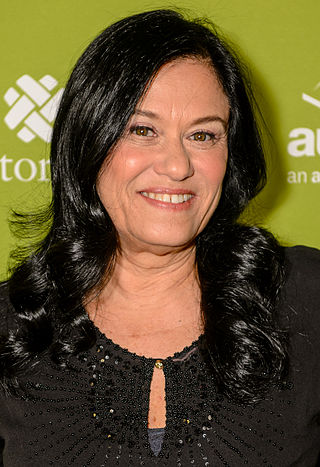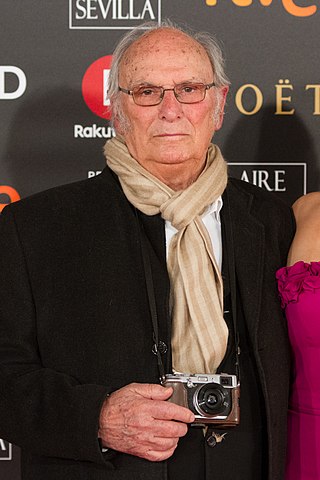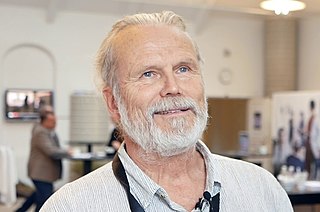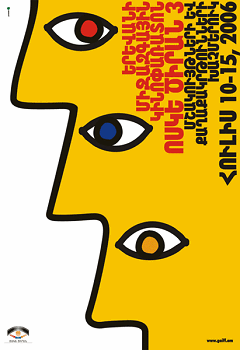Godfrey Reggio | |
|---|---|
 Reggio in 2022 | |
| Born | 1940 New Orleans, Louisiana, U.S. |
| Occupation(s) | Film director, screenwriter |
Godfrey Reggio is an American director of experimental documentary films.
Godfrey Reggio | |
|---|---|
 Reggio in 2022 | |
| Born | 1940 New Orleans, Louisiana, U.S. |
| Occupation(s) | Film director, screenwriter |
Godfrey Reggio is an American director of experimental documentary films.
Reggio was born in New Orleans in 1940 to a Catholic family. He left home at age 14 to join the Catholic Christian Brotherhood. He became a monk, and spent 14 years in silence and prayer during his training. [1] [2]
During the 1950s and 60s, Reggio worked as a social activist with Chicano street gangs with the Brotherhood in New Mexico. One of the brothers introduced him to the film, Los Olvidados, by the Spanish-French-Mexican surrealist filmmaker Luis Bunuel which influenced him greatly. He also acknowledges Artavazd Peleshyan, a documentary-poet, who was a mentor and friend. [1]
Reggio helped found the Institute for Regional Education in Santa Fe, New Mexico, [3] a non-profit foundation. He became a founder of La Clinica de la Gente [4] a facility providing medical care and service to 12,000 community members in northern New Mexico's barrios, [5] [6] [1] as well as founding the Young Citizens for Action, a project aiding juveniles in the street gangs of Santa Fe. [2]
Reggio worked with the American Civil Liberties Union of New Mexico in 1972, to develop a media campaign dealing with the loss of privacy and the rise of surveillance, as well as the militarization of police in the U.S. during the post-Vietnam War era. The media campaign was presented on television, radio, billboards and in major newspapers. [1]
Reggio is widely known for his wordless filmography, especially the trilogy of Koyaanisqatsi : “Life Out of Balance”; Powaqqatsi: “Life in Transformation”; and Naqoyqatsi: “Life as War”. The film titles are taken from the Hopi language. His short film Evidence explores the effect of cinema on the minds of children, and his documentary Anima Mundi , is a montage of images of over seventy animal species. His film Visitors , which premiered at the Toronto International Film Festival, consists for the most part of extended slow-motion closeups of people's faces, looking directly into the camera. [1]
Reggio’s latest film, Once Within a Time, [7] was produced by Steven Soderbergh & Alexander Rodnyansky and had its world premiere at Santa Fe International Film Festival (SFiFF) in October 2022. The festival awarded him the Lifetime Achievement Award. [8]
For many years, he has collaborated with the composer Philip Glass on the musical and orchestral soundtracks that augment Reggio’s wordless films. He also collaborates with Jon Kane, a fellow filmmaker. [8]
In 2014, Reggio was recognized by the Museum of Arts and Design in New York City with a full career retrospective titled Life with Technology: The Cinema of Godfrey Reggio. [9] [10]
The bulk of Reggio's cinematic records, manuscripts, papers, photographs, film rolls, over forty years, have been acquired by Harvard University's Houghton Library, and the Harvard Film Archive. [11]
Reggio's approach to filmmaking is influenced by what came before him. In an interview with Revus et Corriges, he stated that he was particularly influenced by the work of experimental filmmakers such as Stan Brakhage and Maya Deren. Like these filmmakers, Reggio uses film as a medium for exploring the boundaries of perception and consciousness, using the camera as a tool for capturing the unseen and the intangible. [12]
Since the 1960s, Reggio has lived in Santa Fe, New Mexico. [8]
| Year | Name | Director | Writer | Producer | Notes |
|---|---|---|---|---|---|
| 1982 | Koyaanisqatsi | Yes | Yes | Yes | a.k.a. Koyaanisqatsi: Life Out of Balance |
| 1988 | Powaqqatsi | Yes | Yes | Yes | a.k.a. Powaqqatsi: Life in Transformation |
| 1989 | Patricia's Park | Yes | Songlines video segment; short | ||
| 1992 | Anima Mundi | Yes | Yes | a.k.a. The Soul of the World; short | |
| Fated to Be Queer | Yes | Short | |||
| 1995 | Evidence | Yes | Short | ||
| 1995 | The Many Adventures of Diecast | Yes | |||
| 2002 | Naqoyqatsi | Yes | Yes | Yes | a.k.a. Naqoyqatsi: Life as War |
| 2013 | Visitors | Yes | Yes | Yes | |
| 2018 | Awaken | Executive | |||
| 2023 | Once Within a Time | Yes | Yes | Yes |

Powaqqatsi is a 1988 American non-narrative film directed by Godfrey Reggio and the sequel to Reggio's experimental 1982 film, Koyaanisqatsi. It is the second film in The Qatsi Trilogy, which was followed by Naqoyqatsi (2002).

Baraka is a 1992 American non-narrative documentary film directed by Ron Fricke. The film is often compared to Koyaanisqatsi, the first of the Qatsi films by Godfrey Reggio for which Fricke served as cinematographer. It was photographed in the 70 mm Todd-AO format, and is the first film ever to be restored and scanned at 8K resolution.

Santa Fe Indian School (SFIS) is a tribal boarding secondary school in Santa Fe, New Mexico. It is affiliated with the Bureau of Indian Education (BIE).

Cinema of Colombia refers to film productions made in Colombia, or considered Colombian for other reasons. Colombian cinema, like any national cinema, is a historical process with industrial and artistic aspects.

Barbara Kopple is an American film director known primarily for her documentary work. She is credited with pioneering a renaissance of cinema vérité, and bringing the historic french style to a modern American audience. She has won two Academy Awards, for Harlan County, USA (1977), about a Kentucky miners' strike, and for American Dream (1991), the story of the 1985–86 Hormel strike in Austin, Minnesota, making her the first woman to win two Oscars in the Best Documentary category.

Carlos Saura Atarés was a Spanish film director, photographer and writer. With Luis Buñuel and Pedro Almodóvar, he is considered to be among Spain's great filmmakers. He had a long and prolific career that spanned over half a century, and his films won many international awards.

Steen Rasmussen is a Danish physicist mainly working in the areas of artificial life and complex systems. He is currently a professor in physics and a center director at University of Southern Denmark as well as an external research professor at the Santa Fe Institute. His formal training was at the Technical University of Denmark and University of Copenhagen (philosophy). He spent 20 years as a researcher at Los Alamos National Laboratory (1988-2007) the last five years as a leader of the Self-Organized Systems team. He has been part of the Santa Fe Institute since 1988.
The Santa Fe Film Festival is a non-profit organization which presents important world cinema that represents aesthetic, critical, and entertainment standards highlighting New Mexican film. The organization partners with educational groups, schools, and other non-profits to provide a forum for filmmakers, critics, educators, and historians. The award is in the form of a mounted original sculpture. The festival has been listed as one of the top independent film festivals in the United States.
The Cinemanila International Film Festival is an annual film festival held in Manila, Philippines. It was founded by Filipino filmmaker Amable "Tikoy" Aguiluz in 1999. The focus of the festival is on the cinema of the Philippines as well as Southeast Asian cinema.

Aribam Syam Sharma is an Indian filmmaker and composer from Manipur. He debuted in the first Manipuri film Matamgi Manipur as an actor. In 1974, he directed his first movie Lamja Parshuram. It became the first Manipuri film to run for 100 days in the box office. His 1979 film Olangthagee Wangmadasoo was the first ever and the only Manipuri film to run for 32 weeks. It also broke the local box office records of Sholay.

Koyaanisqatsi is a 1982 American non-narrative documentary film directed and produced by Godfrey Reggio, featuring music composed by Philip Glass and cinematography by Ron Fricke.

Let's Make Money is an Austrian documentary by Erwin Wagenhofer released in 2008. It is about aspects of the development of the worldwide financial system, claiming that elitists economically exploit the rest of society, especially in the developing world, but also in western nations.
David Monongye was a Hopi Native American traditional leader. Nephew of Yukiuma, keeper of the Fire Clan tablets, who founded Hotevilla in 1906. He is one of four Hopis who decided or were appointed to reveal Hopi traditional wisdom and teachings, including the Hopi prophecies for the future, to the general public in 1946, after the use of the first two nuclear weapons on Japan.
The Santa Fe International Film Festival (SFiFF), formerly known as the Santa Fe Independent Film Festival, is an American film festival held annually in Santa Fe, New Mexico at the Lensic Performing Arts Center, Violet Crown Cinema, Center for Contemporary Arts, The Screen, and George R.R. Martin's Jean Cocteau Cinema.
Non-narrative film is an aesthetic of cinematic film that does not narrate, or relate "an event, whether real or imaginary". It is usually a form of art film or experimental film, not made for mass entertainment.

The 3rd Yerevan Golden Apricot International Film Festival was a film festival held in Yerevan, Armenia from 10–15 July 2006. The annual festival presented about 120 films from 43 countries. Participants included some of the most highly acclaimed figures of world cinema - such as Marco Bellocchio, Tonino Guerra, Mohsen Makhmalbaf, Godfrey Reggio and Artavazd Peleshyan, who were honored with Lifetime Achievement Awards. More than 110 foreign guests attended the festival, which included filmmakers, actors, producers and distributors. The festival was covered by a number of international media, including Euronews and Arte. The international juries, headed by Moritz de Hadeln, Godfrey Reggio and Arsinee Khanjian, awarded the following prizes: Golden Apricot 2006 for the Best Feature Film to Hou Hsiao-hsien for his film Three Times, (Taiwan/China/France); Golden Apricot 2006 for the Best Documentary Film to Workingman's Death by Michael Glawogger, (Austria); and Golden Apricot 2006 for the Best Film in "Armenian Panorama" to The Dwellers of Forgotten Islands by Hrant Hakobyan, (Armenia).

Mel Lawrence was an American film director and producer and former concert and festival promoter. He is best known for his role as the Director of Operations at the Woodstock Festival, his work on the Qatsi Trilogy, and for directing and producing the Emmy-nominated documentary Paha Sapa: The Struggle for the Black Hills.
Minimalist cinema is related to the art and philosophy of minimalism.
Organism is a short creative documentary film from 1975 made by Hilary Harris.